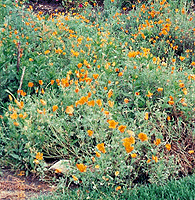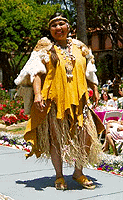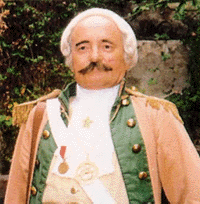 The
natives of Capistrano Valley were known
as the Acjachemen (A HACH A MEN), until
the mission was established. It became
a custom that the Indians surrounding
the mission adopt the name of that mission
thus the local Acjachemen nation became
known as Juanenos.
The
natives of Capistrano Valley were known
as the Acjachemen (A HACH A MEN), until
the mission was established. It became
a custom that the Indians surrounding
the mission adopt the name of that mission
thus the local Acjachemen nation became
known as Juanenos.
Our
state flower, the California Poppy,
is native to this area. The Poppy has
many uses. Poppies along with acorns
were a staple in the diet of the Juanenos.
The seeds were ground into flour and
roots were chewed as pain reliever.
Native
Indian Dress | Mission Indian Dress


Living
History Character Jacque Nunez represents
the natives that actually lived
here. Jacque is a ninth generation
Rios decendant of the Juaneno band
of Mission Indians. Jacque uses
plants to teach the traditions and
songs of her people to visiting
students at the Mission. She holds
"Journeys to the Past"
year round and summer camps.
 Gaspar
Portola
Gaspar
Portola
The
first appointed governor of California,
Gaspar Portola led Father Serra and
soldiers on the first land expedition
from Mexico to California. He wears
an elaborate outfit for the frontier,
along with a fancy powdered wig. This
attire was only worn on formal occasions
as when a king's representative was
visiting.
The
Spaniards' fondness for olive oil made
it a must to grow olives at the Missions.
The tree was also used to produce soap.
Handkerchiefs soaked in perfume were
worn on the sleeve to distract others
from ones unpleasant body odors.
The
only qualifications for a frontier soldier
were to be Catholic, 16 years of age
and with no physical defects. These
fellows were called "Leather Jackets"
because of the several layers of deer
skin vests they wore which weighed 18
pounds.
The
soldier's main job was to protect and
escort the padres, and courier between
Missions. Eventually they became teachers
of the Spanish Language, agriculture,
animal husbandry, and other trades.
As they traveled along Camino Real,
they broadcast mustard seeds which grew
to mark the "Golden Trail"
between all the Missions. The mustard
plants we see covering our hills today
are descendants of those brought here
200 years ago.







